Antimins

The Antimins (literally, "In place of the Table") is a piece of cloth, often silk, that has depicted on it Christ laid out for burial with Icons of the four Evangelists in the corners. [note 7]
Consecrations in Eastern Christianity can refer to either the Sacred Mystery (Sacrament) of Cheirotonea (Ordination through laying on of hands) of a bishop, or the sanctification and solemn dedication of a church building. It can also (more rarely) be used to describe the change of the bread and wine into the Body and Blood of Christ at the Divine Liturgy. The Chrism used at Chrismation and the Antimension placed on the Holy Table are also said to be consecrated.
Eastern Christians believe their bishops to be in apostolic succession, and that at their ordination they receive the fullness of the Divine Grace of the Priesthood (priests and deacons function as the "hands" of the Bishop and are thus an extension of his ministry). The office of bishop is the highest rank in the Church. In their priesthood and bestowed Divine Grace all bishops are equal, and although certain bishops may receive titles such as Patriarch, Metropolitan, or Archbishop, such titles constitute marks of dignity and honor, but not any higher order in the Church or greater measure of grace. At his Ordination, a bishop receives grace to perform all the Sacred Mysteries, including Ordination of others.
The Scriptural foundation for electing and consecration by laying on of hands is found in the Acts of the Apostles (Acts 1:15–26 ; Acts 6:2–6 ) and the Epistles to Timothy (1 Timothy 4:14 ; 2 Timothy 1:6). Just as in Acts there were two stages involved: (a) election and (b) the prayerful laying on of hands, so the Ordination of a bishop in the Eastern Church takes place in two stages: [note 1]
The Greek words meaning ‘dedicate’ and ‘dedication’ are not easy to translate into English, since they also have the connotation of ‘newness’, ‘renewal’. The opening Stichera for Vespers, for example, make frequent play on the ideas of ‘new’ and ‘old’. David, in Psalm 51:10 , asks God to ‘renew a right Spirit within me’, rather than ‘dedicate a right Spirit’. [2]
The Consecration of a Church is a complex service filled with many profound symbolisms. Many biblical elements taken from the Consecration of the Tabernacle (Exodus 40 ) and the Temple of Solomon (1 Kings 8; 2 Chronicles 5–7) are employed in the service. According to Eastern theology, once a building has been Consecrated as a church, it may never again be used for any secular purpose.
No one may construct an Eastern church without the blessing of the local bishop. Before construction begins on a new church, the bishop or his representative lays a foundation stone which may or may not contain relics of a saint. Only after all construction on the new church has been completed may it be Consecrated.
The Eastern ritual for the Consecration of a Church is modeled on the ritual of Baptism and Chrismation. Before the Consecration begins, there is a Great Blessing of Waters as is served at Theophany; [note 4] Chrism, white robes, and tapers are used during the service (the bishop will wear a special white linen garment over his vestments, called a savanon). A procession goes three times around the church building, just like a similar triple procession around the font at Baptism. Another symbolism which occurs frequently in the service is the Incarnation, Passion and Resurrection of Christ.
Relics of Saints (preferably martyrs) are placed in the Holy Table during the Consecration (Revelation 6:9). This is a continuation of the practice of the ancient Church of celebrating the Liturgy over the tombs of the Martyrs.
The Consecration should be performed by the diocesan bishop; but if he is unable to do so, the bishop may delegate an Archimandrite or other senior priest to perform the service in his behalf. The bishop himself must consecrate the Antimension (see below) and send it with the priest who will be performing the service. In this case, the rite of Consecration is briefer than normal. There is no Consecration of the Antimension (since the bishop himself accomplished this earlier), and no Relics are placed in the Holy Table.
There are a number of differences between the rite of Consecration as practiced by the Greeks and as practiced by the Slavic churches. Generally, the Greek rite presumes that the Holy Table will be made of stone, while the Slavic presumes it will be made of wood.
In the Syriac Orthodox Church, the altars are invariably used to be consecrated with the name of St. Mary before the prayer to all the other saints. [3] This type of veneration concerns with the so-called hyperdulia.
If the term "Consecration" is used to refer to the change of the Eucharistic elements (bread and wine) into the actual Body and Blood of Christ, the Eastern Christians emphasize that the Consecration is the Divine response to the Epiclesis, in which the priest invokes the Holy Spirit to come down upon the Gifts and change them. Unlike the prevailing opinion in the West, the Eastern Christians do not hold that there is one specific moment at which this "change" takes place; it is a Sacred Mystery, which begins with the Prothesis (see Liturgy of Preparation). Instead, Eastern Christians would say only that the change is completed at the Epiclesis (rather than at the Words of Institution).
While Eastern Christian declarations have used the term "transubstantiation" (in Greek, "metousiosis") to refer to the change, Eastern Christians often avoid this term, regarding it as an attempt to explain the unexplainable. The shared faith of East and West is "that" the elements are changed, but "how" they are changed is Mystery. The Latin Church too holds that the manner in which the change occurs "surpasses understanding". [4]
Sacred Chrism (Myron) is used for the Chrismation (Confirmation) of the faithful after Baptism. In the Eastern Church the Sacred Mystery of Chrismation is performed immediately after Baptism. Persons from other Christian confessions who are not received into the Church by Baptism may be admitted by Chrismation (depending upon the regulations of the jurisdiction). [note 5] Apostates who have left the Church and then repented and returned are restored after appropriate penance to full communion through Chrismation. [note 6] Chrism is also used in the Consecration of the Holy Table and the entire church building, and is used to anoint the Relics of the Martyrs before they are placed in the Holy Table, and to Consecrate the Antimension. In the past, Chrism was used at the Anointing of Eastern Emperors and Kings.
In the early church, after an individual was Baptized, one of the Apostles would then lay hands upon them and they would receive the Holy Spirit (Acts 8:14–17). According to Eastern Christian Tradition, as the Church grew it became impossible for the Apostles to go to each convert personally, so the Apostles laid their hands upon a vessel of oil, consecrating it, and the oil was distributed to the various churches so that all could receive the gift of the Holy Spirit. Whenever new Chrism is consecrated, it is added to the existing stock. The Eastern Church believes that the same Chrism consecrated by the Apostles is still in use today, having been added-to by all generations of the Church. The earliest mention of the use of Chrism is by Saint Hippolytus of Rome (†235).
While any bishop is empowered to Consecrate the Chrism, so long as he adds to the existing stock; in practice the Consecration is reserved to the Primates who preside over the local autocephalous churches. Traditionally, the Consecration of Chrism occurs during Holy Week. The preparation of the Chrism begins on Great Monday, using a recipe based upon the Anointing Oil consecrated by Moses (Exodus 30:22) Then, on Great Thursday the Patriarch or Metropolitan will consecrate the Chrism. Chrism is not consecrated every year, but only according to need. The Patriarch or Metropolitan will normally make a formal announcement beforehand when there is going to be a Consecration of Chrism.

The Antimins (literally, "In place of the Table") is a piece of cloth, often silk, that has depicted on it Christ laid out for burial with Icons of the four Evangelists in the corners. [note 7]
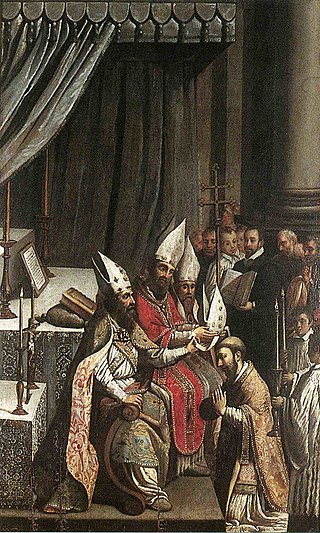
Apostolic succession is the method whereby the ministry of the Christian Church is considered by some Christian denominations to be derived from the apostles by a continuous succession, which has usually been associated with a claim that the succession is through a series of bishops. Those of the Anglican, Church of the East, Eastern Orthodox, Hussite, Moravian, Old Catholic, Oriental Orthodox, Catholic and Scandinavian Lutheran traditions maintain that "a bishop cannot have regular or valid orders unless he has been consecrated in this apostolic succession". These traditions do not always consider the episcopal consecrations of all of the other traditions as valid.
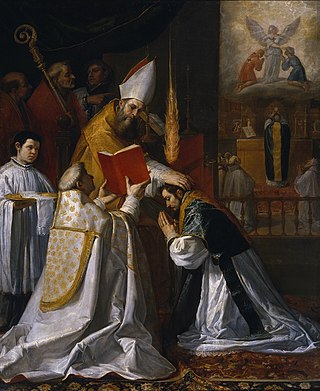
In certain Christian denominations, holy orders are the ordained ministries of bishop, priest (presbyter), and deacon, and the sacrament or rite by which candidates are ordained to those orders. Churches recognizing these orders include the Catholic Church, the Eastern Orthodox, Oriental Orthodox, Anglican, Assyrian, Old Catholic, Independent Catholic and some Lutheran churches. Except for Lutherans and some Anglicans, these churches regard ordination as a sacrament.

Anointing is the ritual act of pouring aromatic oil over a person's head or entire body.
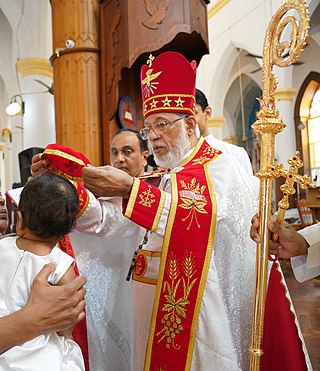
Chrismation consists of the sacrament or mystery in the Eastern Orthodox, Oriental Orthodox and Eastern Catholic churches, as well as in the Assyrian Church of the East initiation rites. The sacrament is more commonly known in the West as confirmation, although Italian normally uses the term cresima ("chrismation") rather than confermazione ("confirmation").

In Christian denominations that practice infant baptism, confirmation is seen as the sealing of the covenant created in baptism. Those being confirmed are known as confirmands. For adults, it is an affirmation of belief. It involves laying on of hands.
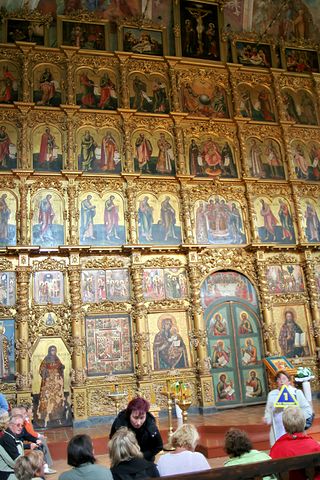
The Byzantine Rite, also known as the Greek Rite or the Rite of Constantinople, is a liturgical rite that is identified with the wide range of cultural, devotional, and canonical practices that developed in the Eastern Christian church of Constantinople.

Chrism, also called myrrh, myron, holy anointing oil, and consecrated oil, is a consecrated oil used in the Catholic, Eastern Orthodox, Oriental Orthodox, Assyrian, Nordic Lutheran, Anglo-Catholics, Old Catholic, and Latter Day Saint churches in the administration of certain sacraments and ecclesiastical functions.

Consecration is the transfer of a person or a thing to the sacred sphere for a special purpose or service. The word consecration literally means "association with the sacred". Persons, places, or things can be consecrated, and the term is used in various ways by different groups. The origin of the word comes from the Latin stem consecrat, which means dedicated, devoted, and sacred. A synonym for consecration is sanctification; its antonym is desecration.

A paten or diskos is a small plate, used during the Mass. It is generally used during the liturgy itself, while the reserved sacrament are stored in the tabernacle in a ciborium.
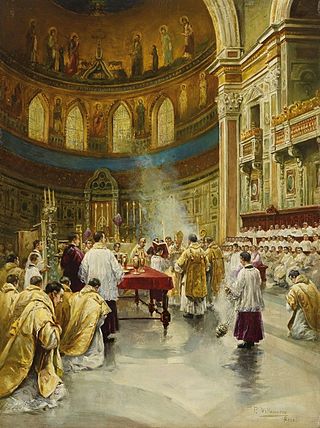
The Chrism Mass is a religious service held in certain Christian denominations, such as Roman Catholicism, Lutheranism, and Anglicanism. It is usually celebrated each year on Maundy Thursday or on another day of Holy Week. During the ceremony, the holy oils used for sacraments and rituals are blessed or consecrated.

The East Syriac Rite or East Syrian Rite, also called the Edessan Rite, Assyrian Rite, Persian Rite, Chaldean Rite, Nestorian Rite, Babylonian Rite or Syro-Oriental Rite, is an Eastern Christian liturgical rite that employs the Divine Liturgy of Saints Addai and Mari and the East Syriac dialect as its liturgical language. It is one of two main liturgical rites of Syriac Christianity, the other being the West Syriac Rite.
In keeping with its prevailing self-identity as a via media or "middle path" of Western Christianity, Anglican sacramental theology expresses elements in keeping with its status as a church in the catholic tradition and a church of the Reformation. With respect to sacramental theology the Catholic tradition is perhaps most strongly asserted in the importance Anglicanism places on the sacraments as a means of grace, sanctification and forgiveness as expressed in the church's liturgy.

The Oil of Catechumens, also known as the Oil of Exorcism, is the oil used in some traditional Christian churches during baptism; it is believed to strengthen the one being baptized to turn away from evil, temptation and sin.

The Euchologion is one of the chief liturgical books of the Eastern Orthodox and Byzantine Catholic churches, containing the portions of the services which are said by the bishop, priest, or deacon. The Euchologion roughly corresponds to a combination of the missal, ritual, and pontifical as they are used in Latin liturgical rites. There are several different volumes of the book in use.

The sacrament of holy orders in the Catholic Church includes three orders: bishops, priests, and deacons, in decreasing order of rank, collectively comprising the clergy. In the phrase "holy orders", the word "holy" means "set apart for a sacred purpose". The word "order" designates an established civil body or corporation with a hierarchy, and ordination means legal incorporation into an order. In context, therefore, a group with a hierarchical structure that is set apart for ministry in the Church.

In the Catholic Church, a bishop is an ordained minister who holds the fullness of the sacrament of holy orders and is responsible for teaching doctrine, governing Catholics in his jurisdiction, sanctifying the world and representing the Church. Catholics trace the origins of the office of bishop to the apostles, who it is believed were endowed with a special charism and office by the Holy Spirit at Pentecost. Catholics believe this special charism and office has been transmitted through an unbroken succession of bishops by the laying on of hands in the sacrament of holy orders.
Presbyter is, in the Bible, a synonym for bishop (episkopos), referring to a leader in local church congregations. In modern Eastern Orthodox usage, it is distinct from bishop and synonymous with priest. Its literal meaning in Greek (presbyteros) is "elder".

There are seven sacraments of the Catholic Church, which according to Catholic theology were instituted by Jesus Christ and entrusted to the Church. Sacraments are visible rites seen as signs and efficacious channels of the grace of God to all those who receive them with the proper disposition.
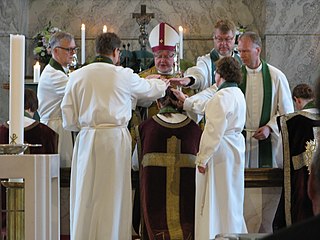
In Christianity, the laying on of hands is both a symbolic and formal method of invoking the Holy Spirit primarily during baptisms and confirmations, healing services, blessings, and ordination of priests, ministers, elders, deacons, and other church officers, along with a variety of other church sacraments and holy ceremonies.
Dedication of churches is a dedication ceremony of a church building. Churches under the authority of a bishop are usually dedicated by the bishop.